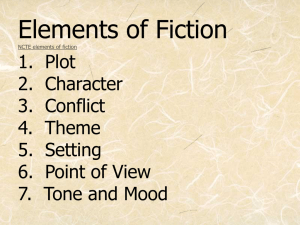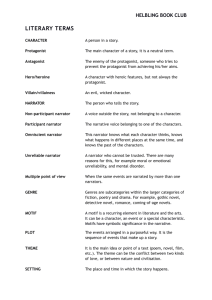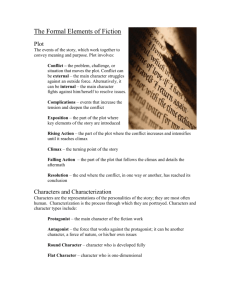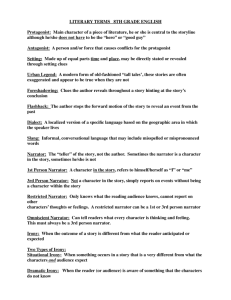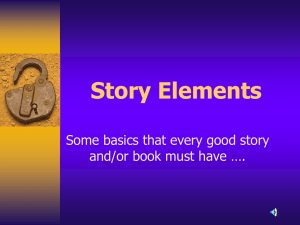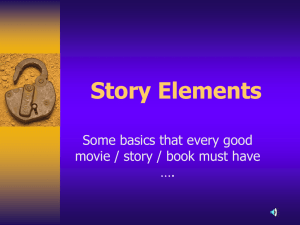Fiction Lesson - Arizona State University
advertisement
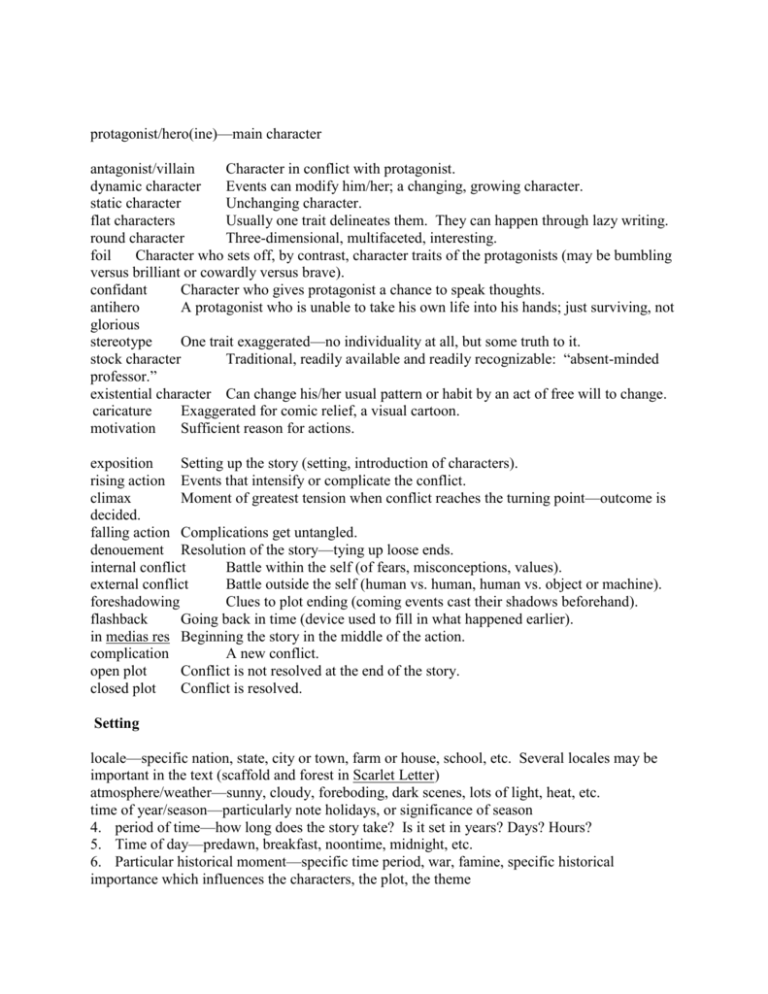
protagonist/hero(ine)—main character antagonist/villain Character in conflict with protagonist. dynamic character Events can modify him/her; a changing, growing character. static character Unchanging character. flat characters Usually one trait delineates them. They can happen through lazy writing. round character Three-dimensional, multifaceted, interesting. foil Character who sets off, by contrast, character traits of the protagonists (may be bumbling versus brilliant or cowardly versus brave). confidant Character who gives protagonist a chance to speak thoughts. antihero A protagonist who is unable to take his own life into his hands; just surviving, not glorious stereotype One trait exaggerated—no individuality at all, but some truth to it. stock character Traditional, readily available and readily recognizable: “absent-minded professor.” existential character Can change his/her usual pattern or habit by an act of free will to change. caricature Exaggerated for comic relief, a visual cartoon. motivation Sufficient reason for actions. exposition Setting up the story (setting, introduction of characters). rising action Events that intensify or complicate the conflict. climax Moment of greatest tension when conflict reaches the turning point—outcome is decided. falling action Complications get untangled. denouement Resolution of the story—tying up loose ends. internal conflict Battle within the self (of fears, misconceptions, values). external conflict Battle outside the self (human vs. human, human vs. object or machine). foreshadowing Clues to plot ending (coming events cast their shadows beforehand). flashback Going back in time (device used to fill in what happened earlier). in medias res Beginning the story in the middle of the action. complication A new conflict. open plot Conflict is not resolved at the end of the story. closed plot Conflict is resolved. Setting locale—specific nation, state, city or town, farm or house, school, etc. Several locales may be important in the text (scaffold and forest in Scarlet Letter) atmosphere/weather—sunny, cloudy, foreboding, dark scenes, lots of light, heat, etc. time of year/season—particularly note holidays, or significance of season 4. period of time—how long does the story take? Is it set in years? Days? Hours? 5. Time of day—predawn, breakfast, noontime, midnight, etc. 6. Particular historical moment—specific time period, war, famine, specific historical importance which influences the characters, the plot, the theme Point of View—includes focus and voice focus Chooses what we can see and from what angle; frames an event; creates proportion, emphasize or de-emphasizing or distorting; focus can be fixed or mobile. persona Voice or figure of the author which tells the story and may or may not be like the real author (often seen in poetry more than fiction). narrator One who tells the story. omniscient narrator Non-participant third person all-knowing narrator who sees through the minds of all the characters. limited omniscient narrator Third person narrator who sees through the mind of a single character. objective (dramatic narrator) Describes events from the outside (fly on a wall)—no inner thoughts. first-person narrator Participant telling story through his/her eyes. second person narrator Monologue addressed directly to the reader (one part of a dialogue with no other characters. You as reader are the second character). naïve observer A character who fails to understand all the implications of the story (a child, someone without experience, someone with diminished mental capacity). stream of consciousness A procession of thoughts passing through the mind randomly. interior monologue Presentation of character’s thoughts in an ordered manner. Theme/message Insight into how individuals relate to their world within the framework of a story—what the author intended to say. See the themes in lit handout. Symbols—something which stands for something else 1. figurative—compares two unlike things (snake as a symbol for evil; names like Faith or Goodman Brown) 2. simile—explicit comparison stated by using like or as 3. metaphor—implicit comparison between two unlike things: “His heart, that bloody motor” 4. allegory—like a metaphor in that one thing is spoken of as another, but rather than one part of a story, the entire story works as a symbol/metaphor—Pilgrim’s Progress, with a man named Christian, who meets other characters named Pliable or Obstinate, etc. Allegory is often about the journey of life through temptations, redemption, etc. 5. myth—when an entire story is symbolic, it is sometimes called a myth, in this case, meaning of communal origin & providing an interpretation of man, nature, universe, and the relation among them Miscellaneous 1. Tone—author’s choice of details, character, event, and situations, and words that lead us to infer the author’s attitude (or the persona the author uses, which may not be the author’s personal attitude): amusement, anger, affection, sorrow, contempt, hate 2. Style—individual traits and characteristics of a piece of writing; a writer’s particular way of managing words, the language a writer uses, length and complexity of sentences, habitual use of imagery, patterns of sound, etc. 3. Irony—meaning of words different from speaker’s meaning: a discrepancy between what is said and what is meant; wry contrast or incongruity in a situation 4. Allusion—historical or biblical or cultural references


